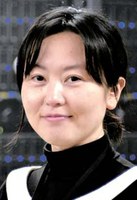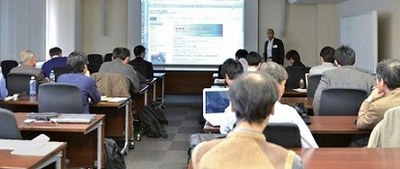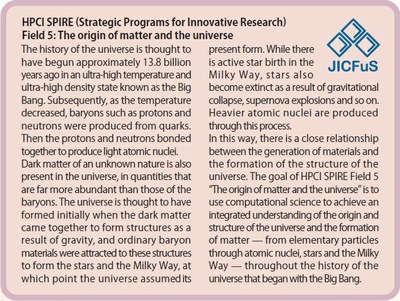Special Feature 2:Collaboration between SPIRE Field2×Field5
Aiming for Breakthroughs through Interdisciplinary Exchange
 |
Atsuko Irie
Assistant Technical Staff, |
|---|
Increasing collaboration between SPIRE Field 2 and Field 5
It has been three years since the HPCI SPIRE (Strategic Programs for Innovative Research)program began. During this period, an annual Interdisciplinary Exchange Workshop where researchers in Field 2 “New materials and energy creation” and Field 5 “The origin of matter and the universe” can discuss issues common to both fields has been held. In the area of research support as well, a cooperative organization is being built. The targets of Field 2 research are solid state science, molecular science and materials science, while the targets of Field 5 r search are elementary particles, atomic nuclei and space. Despite the fact that these two fields appear at first glance to be different in terms of both targets and the scale of the research, why is progress being made on collaboration between these two SPIRE fields?
Field 2 and Field 5 differ in terms of the components making up the system that is the target of the research. However, the physical laws that are used to describe the various properties and changes are very similar. For this reason, the fields face many of the same issues in terms of theory and calculation methods. Collaboration between the two fields is aimed at discussing these common issues and cooperating with one another to resolve them.
A look back at history reveals that exchanges between materials science researchers and elementary particle and nuclear science researchers has produced many breakthroughs in the past. Famous among these is the example of Professor Yoichiro Nambu,recipient of the 2008 Nobel Prize in Physics,for whom the Bardeen‐Cooper‐Schrieffer(BCS) theory that explains the physical phenomenon of superconductivity led to the idea for spontaneous symmetry breaking,the breakthrough for which he was awarded the Nobel Prize.
One example of a specific issue that is common to both Field 2 and Field 5 is quantum nature, a universal aspect of fields in the micro realm. In Field 2, researchers study electrons and ions in materials, while in Field5 researchers study the protons, neutrons and other particles that make up atomic nuclei, as well as the quarks and gluons that make up those particles. Within the many research
endeavors, there are actually many issues that these fields have in common, such as the development of rigorous calculation methods and approximate means methods for quantum many-body systems and the construction of models and so on. There are also commonalities in terms of the gravity simulations used in space and the molecular dynamics simulations used in materials science. Molecular dynamics calculations are used for elementary particle lattice QCD calculations and atomic nuclei collision phenomena as well. The common attributes of issues such as these are not limited to Field 2 and Field 5, but to understand the common elements that are based on physics, it is essential to first deepen collaboration between these two SPIRE fields that are separated only by low barriers.
Interdisciplinary Exchange Workshop
The third Field 2 × Field 5 Interdisciplinary Exchange Workshop was held November 13 and 14, 2013 at the Institute for Molecular Science in the National Institutes of Natural Sciences, located in the city of Okazaki. The workshop featured 16 pairs of presentations, and 40 participants engaged in spirited discussion.The topic was “Dynamics calculations for quantum many-body systems.” In the background of this topic is the fact that it has recently become possible in materials science research to observe the course of chemical reactions in units of femtoseconds (Ten to the minus 15th power second) and attoseconds (Ten to minus 18th power second). In order to do this, it is necessary to calculate thequantum dynamics of electrons and ions in a time domain. In nuclear physics, on the other hand, simulations of nuclei collisions using time-dependent mean field theory have been developed since the 1970s. Presentations at the Interdisciplinary Exchange Workshop centered on photoelectron dynamics calculations and mixed classical and quantum dynamics calculations from the fields of molecular science and materials science, and quantum dynamics calculations relating to photoresponse and collision phenomena from the nuclear field.
Presentations at the Interdisciplinary Exchange Workshop centered on photoelectron dynamics calculations and mixed classical and quantum dynamics calculations from the fields of molecular science and materials science, and quantum dynamics calculations relating to photoresponse and collision phenomena from the nuclear field.
At previous Interdisciplinary Exchange Workshops, there were many presentations based on large-scale calculations, and there were also presentations from the fields of mathematical science and computer science.
“This time, the presentations were not necessarily limited to large-scale calculations, and there was an awareness of the need to search for seeds for which large-scale calculations will be needed in the future,” says Professor Kazuhiro Yabana of Tsukuba University, who served as facilitator for the workshop. “For this reason, the emphasis was on physics as well as calculations.” Associate Professor Katsuyuki Nobusada of the Institute for Molecular Science, who also served as facilitator, said in his greeting at the start of the workshop that he hoped that the participants“would seize the opportunity to perform large-scale calculations in the future.”
Research support
The Interdisciplinary Exchange Workshop also featured presentations regarding research support. Researcher Kazuya Ishimura provided a report and information regarding the CMSI young researcher technical workshops???, which are held to share information and technologies such as programming, tuning and so on, and the “TOKKUN!”CMSI application advancement training camp.In SPIRE Field 5, a user support* team made up of researchers in the elementary particle, atomic nuclei and space fields and computational science researchers has been organized.If there is a request from a researcher somewhere in Japan in the field of elementary partcle, atomic nuclei or space, the team members who are knowledgeable about the content of the request propose solutions and provide advice. In the past, the team has handled issues relating to efficient parallel computing algorithms, requests for recommendations of visualization software, routines for solving differential equations, the development of special diagonalization routines and so on.In the future, SPIRE Field 5 researchers will attend SPIRE Field 2 workshops and other events, and requests for assistance from Field2 researchers will be accommodated in Field5 user support activities. In this way, the researchers will establish closer relationships in the area of research support as well.
young researcher technical workshops???, which are held to share information and technologies such as programming, tuning and so on, and the “TOKKUN!”CMSI application advancement training camp.In SPIRE Field 5, a user support* team made up of researchers in the elementary particle, atomic nuclei and space fields and computational science researchers has been organized.If there is a request from a researcher somewhere in Japan in the field of elementary partcle, atomic nuclei or space, the team members who are knowledgeable about the content of the request propose solutions and provide advice. In the past, the team has handled issues relating to efficient parallel computing algorithms, requests for recommendations of visualization software, routines for solving differential equations, the development of special diagonalization routines and so on.In the future, SPIRE Field 5 researchers will attend SPIRE Field 2 workshops and other events, and requests for assistance from Field2 researchers will be accommodated in Field5 user support activities. In this way, the researchers will establish closer relationships in the area of research support as well.
Collaboration between SPIRE Field 2 and Field 5 may once again produce breakthroughs in these fields such as the one produced by Professor Nambu. We look forward to the achievements of their activities in the future.
(Assistance: Kazuhiro Yabana, University of Tsukuba)

* User support For more information on user support offered in SPIRE Field 5, go to:
http://www.jicfus.jp/field5/en/promotion/user/

